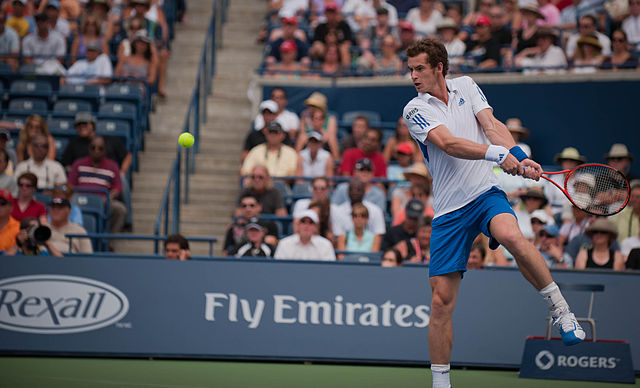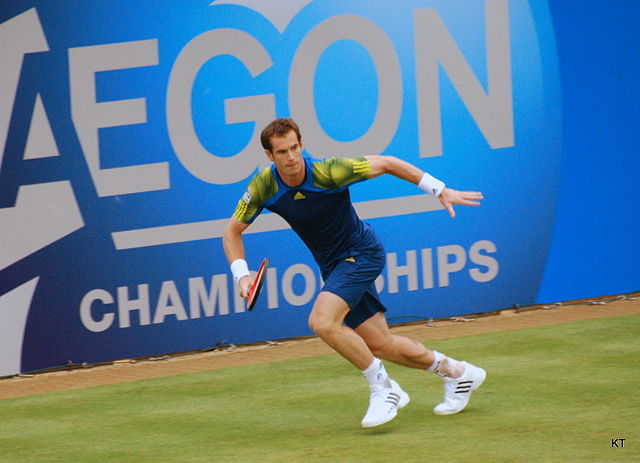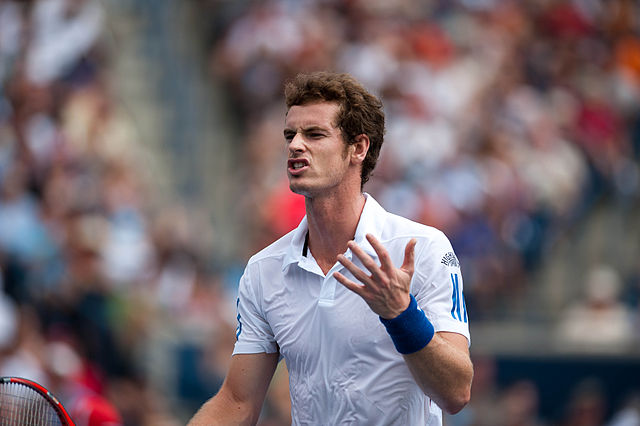
Credit: johnwnguyen
I’m counting down the 128 best players of the last century. Whee!
* * *
Andy Murray [GBR]Born: 15 May 1987
Career: 2005-present
Plays: Right-handed (two-handed backhand)
Peak rank: 1 (2016)
Peak Elo rating: 2,347 (2nd place, 2017)
Major singles titles: 3
Total singles titles: 46
* * *
It’s November 29th, 2015. We’re at the Flanders Expo in Ghent, Belgium, where the hosts have laid down a surface of indoor clay. The Brits lead the Davis Cup final, two rubbers to one. David Goffin is serving, down two sets, 3-5, 30-40.
Match point, Andy Murray. Championship point, Great Britain, to reclaim the Cup it last held 79 years ago, when it was Fred Perry leading the charge.
In the last, marvelous exchange, we can see everything that makes Murray such an indefatigable opponent.
Goffin serves down the tee, and Murray replies with a deep forehand up the middle. Andy’s second shot is nearly the same, nudging the Belgian a bit to his backhand. Goffin puts a crosscourt shot right into the corner; Murray replies with the same. Another Goffin backhand, a sharp-angled reply from the Brit, and now it’s the server’s turn to play defense.
Goffin resets the point with a deep backhand down the middle; Murray pushes him back into the corner he came from. The Belgian returns to the crosscourt pattern and shades to his backhand side; Andy mixes things up with a modest slice to the open court. Goffin is paying attention, too: He flat-foots Murray with a forehand up the line, drawing a defensive slice that the Belgian looks to attack. But it drifts too far to his left. Goffin runs around it and hits an inside-out forehand, going crosscourt to the Murray backhand yet again.
While Murray isn’t off balance, he doesn’t have many options. He muscles a two-hander right back to the Belgian, who is camping out in his backhand corner. Finally, Goffin has the opportunity he’s been working up to. He steps all the way into the doubles alley and puts all of his 150 pounds behind a forehand up the line. The home crowd roars. Half of the guys on tour would stand and watch this one go by; half of the rest would give chase and come up short.
Even though Andy wasn’t expecting it, he runs it down. Barely: After a diagonal sprint to move even further behind the baseline, he lunges and chips a forehand crosscourt, just over the net. The result is a sitter for the Belgian. The only thing stopping him from an easy putaway is the distance he has to cover. Goffin needs to put a little topspin on his down-the-line forehand, which gives his opponent an extra half-second to get there.
This time, Murray knows where he needs to be. The moment he finds his footing, he books it back along the baseline. By the time Goffin’s second would-be winner reaches him, he needs only one little adjustment step to get into position. He flicks a backhand lob crosscourt over the head of the Belgian, who makes a half-hearted move before giving up. Andy’s shot is untouchable, and it lands comfortably inside both lines. Game, set, match, championship, Great Britain.
This is what Andy Murray does.
* * *
It is hard to be more specific. As early as 2009, Paul Annacone said that Murray might be the best counterpuncher on tour. Pinning down a definition of “counterpuncher” is where things get tricky.
The Brit’s game is anticipation, resourcefulness, and courtcraft. He isn’t wily by necessity, though. Murray is six-feet, three-inches tall, and he can crank serves up to 130 miles per hour. In a 2016 Davis Cup clash with Juan Martín del Potro, he tallied 35 aces. No counterpunching there.
As we saw in that single point against Goffin, Murray can hit just about any shot from just about any position. He rarely rushes into an aggressive stroke; he is content–some would say too content, especially when he was young–to wait for his opponent to make the first move. He didn’t hit the Davis Cup-deciding lob until the 20th shot of the rally. One wind-blown exchange with Novak Djoković in the 2012 US Open final ran to 54 shots.
Counterpunching is hard to quantify, but there are a couple of aspects of the Murray defense that we can measure. First, he takes away aces. Since 2000, about 7% of points on the ATP tour end with a single shot. Murray limits opponents to about 5.5%. On a good day, his impact is far greater. Milos Raonic managed a measly eight aces in the three sets of the 2016 Wimbledon final.
I don’t know whether knocking 1.5 percentage points off the tour average sounds impressive. It should. Very few players are able to influence ace rates at all. Djoković allows aces on about 6.5% of his return points; Rafael Nadal is right at 7%. The only man who has kept more serves in play than Murray for several years running is Gaël Monfils. The Frenchman may not be the best role model here. He prevents aces only by camping out at the back wall of the court next to the line judge.
The other Murray asset we can put a number on is his lob. He’s rightly considered to have the best lob in the game, especially since the retirement of Lleyton Hewitt. In the nearly 250 Murray matches logged by the Match Charting Project, Andy averages about five lobs per outing, more than any modern player of note. (Björn Borg and Mats Wilander hit more, because they often faced netrushers.)
Of those 1200-plus lobs, Andy has arced 71 of them for clean winners. Opponents got a racket on another 45, but didn’t put them back in play. Again, I don’t know if those numbers sound particularly impressive. As with his ace prevention, Murray’s lob winners rank him among the very best in the game. His rates–a lob winner every third match, an unreturnable one every second–are exactly in line with Hewitt’s. A few younger players, notably Alejandro Davidovich Fokina, have won more points with their lobs in the last couple of years, but it remains to be seen whether anyone else can sustain Murray’s level of lobbing prowess for as long as he has.
* * *
The thing is, neither of these skills has much direct impact on a player’s results. They reflect extraordinary skill, no question. They indicate defensive talents that may deliver a greater payoff elsewhere. But one or two lob winners every week? One ace prevented per match, converted into a rally he might not even win? No matter how small the margins in tennis, we have a lot more work to do to explain how Murray became number one.
One of the Brit’s prime gifts is the ability to keep the ball in play. Does that show up in the numbers?
Back to the Match Charting Project data. In the men’s game on a hard or grass court, a non-slice groundstroke ends the point–via a winner or an induced forced error–about 10.5% of the time. (I’ve excluded clay because the tactics are different, it’s not where Andy made his reputation, and we don’t have as much data on his performance there.) We’d expect that the best retrievers and counterpunchers hold that point-ending rate lower.

Credit: Carine06
Sure enough, Murray holds opponents to winners and forced errors on only 8.3% of their groundstrokes. Several of the game’s best defensive players–Djoković, David Ferrer, Daniil Medvedev, Carlos Alcaraz–are at or just above 8%. Stan Wawrinka ranks there too. Murray doesn’t stick out as the very best player in this department, but he beats out around nine in ten of his peers.
(Oddly enough, the leader in this category–by a wide margin!–is Nikoloz Basilashvili. While the usual way to prevent winners is a solid defensive game, a valid alternative is to crush every groundstroke with such force that opponents are lucky to get out of the way, let alone direct their reply to a corner.)
Now we’re getting somewhere. The difference between the tour average of 10.5% and Murray’s 8.3% means that he erases four or five point-ending groundstrokes per match. That doesn’t directly translate into the same number of points–his forehand slice on the stretch against Goffin, for instance, could have just set up his opponent to win the point with his next shot.
Let’s cut the number in half and round down, giving us an estimate that Murray’s defensive skills at the baseline are worth two extra points per match. I calculated several years ago that one additional point per thousand translates to a one-spot bump up the rankings. (The gap is a bit bigger among the top few places on the table.) The average match spans about 140 points, so Andy’s groundstroke-winner prevention is worth about 14 points per thousand. Using my points-to-ranking rule of thumb, this single attribute is enough to represent the difference between a top-tenner and a player outside the top 20.
* * *
Four or five extra recoveries is nothing compared to what Murray could do on his best day.
In the 2012 US Open final, Andy allowed Novak Djoković only 30 groundstroke winners and induced forced errors. In five long, bruising sets, that’s nothing. Djoković usually ends points on about 9% of his groundstrokes. Given the number of shots he had to hit against Murray that day, a less gifted retriever would’ve allowed him a whopping 73 winners and forced errors.
In other words, Murray held one of the best players of all time to fewer than half the number of point-ending groundstrokes he would normally hit.
All of the Brit’s greatest triumphs followed the same script. On a typical day, he cut back the opposition’s point-ending groundstrokes by 17%. With more on the line, he went much further. The following table shows Murray’s six most prestigious championship finals, along with the number of winners and forced errors his opponents would have been expected to hit against an average player (“Exp W+FE”), the actual number he allowed (“Actual”), and the percentage of expected winners that he stopped (“Difference”).
Final Opponent Exp W+FE Actual Difference 2012 Olympics Federer 28 17 40% 2012 US Open Djoković 73 30 59% 2013 Wimbledon Djoković 45 30 34% 2016 Wimbledon Raonic 30 16 46% 2016 Olympics del Potro 44 32 28% 2016 Tour Finals Djoković 25 11 57%
Djoković often did the same thing in return. In the 2013 Australian Open final, for example, Novak prevented more than half of the point-ending groundstrokes Murray would have tallied against a typical opponent.
Baseline defense was the deciding factor in many of their 36 encounters. At the 2012 US Open, Djoković recovered 32 balls that a typical man wouldn’t have gotten back. That’s pretty good, but Murray saved 43. In their four-hour, 54-minute struggle, Andy won 160 points to Novak’s 155. Had Murray been a smidgen slower, a touch lazier, or the tiniest bit less resourceful, he would have waited even longer for his first major title.
* * *
Illuminating as they are, these numbers miss much of what makes Murray great. The tactical game begins before anyone steps on court, and that tilts the scale even further in Andy’s favor.
Adversaries know that he’ll get lots of balls back. Some players react by taking more chances. Roger Federer tried that in some early meetings. In 2008, at both Dubai and Madrid, Federer recorded more point-ending groundstrokes than usual, something that few players have ever managed against Murray. It was only possible due to an unusual level of aggression–Fed hit more than his typical number of unforced errors, too. Andy won six of his first eight meetings with Roger, including those two matchups with a hyper-aggressive Fed.
Even if an opponent comes in with a strong strategic plan, Murray has a knack for throwing it off. Andy Roddick called his game “confuse and conquer”–and that was when the Brit was only 20 years old. Murray’s baseline arsenal includes everything from loopy topspin to net-skimming darts; he makes frequent use of a slice, which serves to disguise a vicious drop shot. The longer the exchange, the more time he has to out-think the man across the net.
Oh, and his skills at net, according to Paul Annacone, are among “the most underrated on tour.” In Great Britain’s 2015 Davis Cup campaign, Murray secured three doubles rubbers with brother Jamie. He also won an Olympic silver medal in mixed doubles.
The sum total of Murray’s game makes him one of the most frustrating men to serve against. Among recent players, only Djoković is as good as blunting first-strike power and fighting back to even terms. “Against Andy,” del Potro said at the 2016 Olympics, “you never know if you’re going to win your serve.”
Delpo might have phrased it differently: You can be pretty sure you won’t always hold your serve. Andy converted nine break points against the Argentinian in the Rio final alone. In 2016, Murray broke serve at least once in every one of his 87 matches. His streak lasted almost two full years and reached 136 straight–the sixth-longest run since 1991, when the ATP started recording break point stats. Only Hewitt, Nikolay Davydenko, Andre Agassi, and Nadal (twice) have won return games in so many consecutive matches.
* * *
I wonder if future generations of fans will recognize just how strong a player Murray was during his nearly decade-long peak. His grand slam tally of “only” three titles leaves him far down the all-time list. Even his most stalwart fans tend to underrate him against famous names from earlier, weaker eras.
When Andy established himself among the game’s elite, he had to fight for recognition next to the Big Three of Federer, Nadal, and Djoković. Injuries have now consigned Murray to a supporting role on tour, so once again, people exclude him to talk about the Big Three. We’ve entered a new era, and Andy doesn’t merit a place in discussions of 20-slam winners.
Neglect him at your peril. The Brit was better than you think, earlier than you think. He cracked the top three in my Elo ratings in 2008, creeping ahead of Djoković. He finished third again in 2009, pushing Nadal down the list and ending the season only a couple dozen points behind first-place Federer. He underperformed at the majors, but he was a consistent threat everywhere else. In both 2008 and 2009, he beat every member of the Big Three, racking up ten such upsets in a two-year span.

Credit: johnwnguyen
When he slid to fourth place in 2011 and 2012, he remained about as close to number one (in Elo terms) as number five ever got to him. Had I applied the ranking algorithm behind the Tennis 128 at the end of 2012, the 25-year-old Murray would’ve already merited a place among the top 100 players of the last century.
The Wimbledon titles, the French Open final, the second Olympic gold, the 41 weeks at number one–everything Murray achieved between 2013 and 2017 has merely cemented the reputation he deserved after winning his first major in 2012. “Big Three” is a useful term for discussing the very greatest players of all time, but if we’re talking about the era in which they played, the only logical grouping gives us a Big Four.
Murray will always be the junior member of the quartet. But as Djoković would be the first to tell you–panting, after a five-hour slugfest–the gap between them was never that wide.